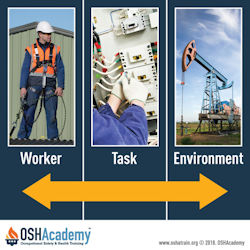Ergonomic Hazards
Introduction
Ergonomics (er'gõ nom'iks) Defined
Ergonomics is the science of designing work so it fits the people doing it. Good ergonomic practices reduce the risk of injury, boost productivity, and improve overall worker comfort.
Ergonomics also means working smarter, not harder. It looks at the following risk factor categories to see how the job can best fit the worker:
- Risk factors inherent in the worker: Physical, psychological, and non-work-related activities may present unique risk factors. Instead of forcing workers to adjust their bodies to uncomfortable tools, tasks, or environments, ergonomics focuses on adjusting the job to fit the worker. The science of ergonomics studies and evaluates a full range of tasks including, but not limited to, lifting, lowering, holding, pushing, pulling, walking, and reaching.
- Risk factors inherent in the task: Work procedures, equipment, and workstation design may introduce risk factors. Ergonomic hazards are avoided primarily by the effective design of a job or jobsite and better designed tools or equipment that meet workers' needs in terms of physical environment and job tasks. Through worksite analysis, employers can set up procedures to correct or control ergonomic hazards. For example:
- using the appropriate engineering controls (e.g., designing or re-designing work stations, lighting, tools, and equipment)
- teaching correct work practices (e.g., proper lifting methods)
- employing proper administrative controls (e.g., shifting workers among several different tasks, reducing production demand, and increasing rest breaks)
- if necessary, providing and mandating personal protective equipment
- Risk factors inherent in the environment: The physical and psychosocial work environment or "climate" may introduce risk factors. Overall, industrial hygienists point out that the benefits of a well-designed, ergonomic work environment can include increased efficiency, fewer accidents, lower operating costs, and more effective use of personnel.
Knowledge Check Choose the best answer for the question.
6-1. Which situation is an example of a risk factor inherent in the task?
You forgot to answer the question!

